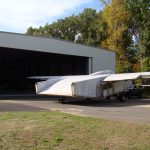
The New England Air Museum in Windsor Locks, Connecticut is currently undertaking the wholesale restoration of their Douglas DC-3, and WarbirdsNews thought our readers would enjoy hearing about their progress so far. Interestingly, this really is a DC-3, rather than the far more numerous C-47 military transport variant, being one of thirteen ordered by American Airlines prior to the US entering WWII. The US Army Air Corps took over the contract though while the aircraft was still on the production line, and so the aircraft became C-49J as a result. She entered service as 43-1973 in November, 1942 and took the fight to the Axis powers during WWII. The Army Air Force released the aircraft in April, 1945, whereupon she returned to the factory for conversion back into a DC-3, flying again by November. She joined Purdue University following a stint with Eastern Airlines, then Basler Airlines into the 1970s before joining Florida Airmotive Services, her final operator. The New England Air Museum acquired her in November, 1992, and she touched down at their base at Bradley International Airport in Windsor Locks, Connecticut on her final flight shortly after. The DC-3 went on public display outdoors in her Florida Airmotive Services/Taino Airlines colors having accumulated 53,434 flying hours. Over the years, the aircraft has undergone minor restorative work, but more recently, the museum decided to restore the interior… stripping out and refurbishing the seats, windows, carpeting, ceiling headliner, side walls, and attendant station materials etc.
However, the scope expanded to include exterior restoration as well. As the museum describes their plans… “The exterior restoration plan is to reconfigure the aircraft livery into a classic polished aluminum skin appearance popular with the major domestic airlines of the 1940s/1950s. Funding for the paint removal was obtained from a generous donation by the John G. Martin Foundation in West Hartford, CT and an environmentally compatible chemical stripping process was selected for the paint removal process as the least harmful to the aircraft’s aluminum skin surfaces. A contract was finalized with Straube’s Aircraft Services Hawaii and the on-site work was scheduled for mid-June.”
During the spring of 2014, NEAM volunteers choreographed the complicated procedure of moving the DC-3’s fuselage from the Civilian Display Hangar to the adjacent Storage Hangar so the paint removal could take place. Moving the large fuselage through the cramped confines of the display building was a difficult and time consuming process. It involved a detailed plan which called for the repositioning of six fixed winged aircraft, a helicopter and various displays, but the DC-3 was finally in the Storage Hangar by late May. Straube sent three of their personnel to perform the paint stripping in June, and after two applications of stripper, the aircraft was fully bare.
NEAM personnel evaluated the exposed skin for surface corrosion and polished several small areas on the fuselage to determine if a fully polished skin finish was possible. They museum was happy with the way the skin cleaned up, and decided to proceed with polishing the entire airframe. With technical advice from the Detailer Supply Company in nearby East Windsor, Connecticut, the restoration crew picked an appropriate polishing compound and spent a day each week working on the aircraft skin from July through December 2014. By year’s end, they had finished the horizontal stabilizers and tail fairing and completed about 60% of the fuselage polishing. The outer wing panels were yet to be touched by that point though.
NEAM volunteers have brought one of the outer wing panels into the heated Restoration Hangar and have begun polishing it in recent weeks. They have also been working hard on restoring the seat frames, repairing and repainting them, with reupholstering set to commence soon. The museum has not yet decided which airline livery to finish the DC-3 in, but that should happen this year, and once the polishing is completed, museum staff will paint on the various markings and details to bring the aircraft back to her former glory. WarbirdsNews will be sure to follow this work, and report on it as soon as we receive the details. The New England Air Museum does an incredible job with the preservation and presentation of aviation history. None of this work could be accomplished without a legion of volunteers and dedicated staff though. The DC-3 is being shepherded through its restoration by crew chief Mark Holby and his volunteers Willie Althammer, Carl Cruff, Robert Kalogeros, Keith Lindstrom, Rich Pereira, and Carol Shuteran. We should all wish them a hearty congratulations for the work they have accomplished so far, and thank them for their efforts in keeping our shared history secure.

































